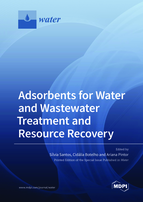Adsorbents for Water and Wastewater Treatment and Resource Recovery
A special issue of Water (ISSN 2073-4441). This special issue belongs to the section "Wastewater Treatment and Reuse".
Deadline for manuscript submissions: closed (30 November 2020) | Viewed by 112564
Special Issue Editors
Interests: adsorption; wastewater treatment; natural adsorbents; toxic metalloids; metal recovery
Special Issues, Collections and Topics in MDPI journals
2. ALiCE - Associate Laboratory in Chemical Engineering, Faculty of Engineering, University of Porto, 4200-465 Porto, Portugal
Interests: water chemistry; water treatment; adsorption
Special Issues, Collections and Topics in MDPI journals
Interests: water and wastewater treatment; adsorption; low-cost materials; removal of heavy metals; nutrient recovery
Special Issues, Collections and Topics in MDPI journals
Special Issue Information
Dear Colleagues,
Adsorption is a well-established operation commonly used in water and wastewater treatment. In the last decade, the search for alternative adsorbents has rocketed up, which is partially explained by the increasingly demanding standards and discharge limits imposed by legislation, the recognition of new and emerging contaminants and by the interest to reuse treated water in multiple applications. Additionally, in the current context of promoting an efficient use of natural resources and energy, many adsorbents based on natural and waste materials and requiring minimal processing have been proposed as alternatives to the conventional ones. Now is also the time when the contribution of the adsorption to the circular economy has been stepping up, going beyond the removal of harmful contaminants from water, and going towards the recovery of substances of economic interest or in risk of scarcity.
This special issue invites the submission of original research papers or review papers covering the latest findings and progresses in this field. We are keen to receive contributions reporting results with different kinds of adsorbents/biosorbents and for different applications (drinking-water treatment, purification of irrigation water, wastewater decontamination, industrial wastewater treatment, among others), covering a wide range of adsorbates (heavy metals, toxic metalloids, surfactants, dyes, nutrients, pharmaceuticals, personal care products, pesticides, among others). Contributions related to the recovery of substances from aqueous solution (e.g.: phosphate, critical and precious metals) will be also highly welcomed.
Dr. Sílvia Santos
Prof. Dr. Cidália Botelho
Dr. Ariana Pintor
Guest Editors
Manuscript Submission Information
Manuscripts should be submitted online at www.mdpi.com by registering and logging in to this website. Once you are registered, click here to go to the submission form. Manuscripts can be submitted until the deadline. All submissions that pass pre-check are peer-reviewed. Accepted papers will be published continuously in the journal (as soon as accepted) and will be listed together on the special issue website. Research articles, review articles as well as short communications are invited. For planned papers, a title and short abstract (about 100 words) can be sent to the Editorial Office for announcement on this website.
Submitted manuscripts should not have been published previously, nor be under consideration for publication elsewhere (except conference proceedings papers). All manuscripts are thoroughly refereed through a single-blind peer-review process. A guide for authors and other relevant information for submission of manuscripts is available on the Instructions for Authors page. Water is an international peer-reviewed open access semimonthly journal published by MDPI.
Please visit the Instructions for Authors page before submitting a manuscript. The Article Processing Charge (APC) for publication in this open access journal is 2600 CHF (Swiss Francs). Submitted papers should be well formatted and use good English. Authors may use MDPI's English editing service prior to publication or during author revisions.
Keywords
- adsorption
- biosorption
- water
- wastewater
- water reuse
- emerging contaminants
- heavy metals
- critical metals
- phosphate recovery








